[Click on any photo to enlarge.]
*Critters we’ve seen on our
2015 trip so far: elk, mule, mule deer, llama, prairie dog, donkey
*Birds we’ve seen on our 2015
trip so far: California condor, Brewer’s blackbird, American kestrel, spotted
towhee
*National Parks/Monuments visited on 2015 trip so far: 3
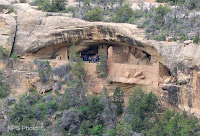 As
mentioned in the last post, only the Balcony House was available for ranger
guided tours and is considered the most adventurous of the three tours, rated
as strenuous. Located at 7,000 ft., it’s
a 1 hour tour that involves climbing a 32 ft. wooden ladder, crawling through a
12 ft. long 18 in. wide tunnel, and climbing up a
As
mentioned in the last post, only the Balcony House was available for ranger
guided tours and is considered the most adventurous of the three tours, rated
as strenuous. Located at 7,000 ft., it’s
a 1 hour tour that involves climbing a 32 ft. wooden ladder, crawling through a
12 ft. long 18 in. wide tunnel, and climbing up a
 60 ft. exposed face cliff by
way of two 10 ft. ladders and a series of stone steps. Piece of cake, right? It did sound a little nerve wracking and part
of me wasn’t sure I wanted to attempt it (neither was Russ), but when we found
out the price (only $4 per person), I decided I had to go for it. Tickets are purchased at the visitor center
with various times throughout the day, and after seeing the mockup of the
tunnel which didn’t look so bad, we got two for noon the following day.
60 ft. exposed face cliff by
way of two 10 ft. ladders and a series of stone steps. Piece of cake, right? It did sound a little nerve wracking and part
of me wasn’t sure I wanted to attempt it (neither was Russ), but when we found
out the price (only $4 per person), I decided I had to go for it. Tickets are purchased at the visitor center
with various times throughout the day, and after seeing the mockup of the
tunnel which didn’t look so bad, we got two for noon the following day.


 We met up
with Ranger Abby shortly before noon, and it looked like there’d be about 15 of
us. Then just as we were about ready to head
for the metal stairs that would take us down to one of the ledges, a bus pulled
up with about 25 third graders! We had
hoped for a small tour group but oh well.
We met up
with Ranger Abby shortly before noon, and it looked like there’d be about 15 of
us. Then just as we were about ready to head
for the metal stairs that would take us down to one of the ledges, a bus pulled
up with about 25 third graders! We had
hoped for a small tour group but oh well.
 The house
was built in the late 1200s and consisted of about 40 rooms. One needs to be extremely careful not only because
of the ladders and tight openings, but there are no guard rails (though most of
the time you’re not that close to the edge).
We made stops in a couple of places so Abby could
The house
was built in the late 1200s and consisted of about 40 rooms. One needs to be extremely careful not only because
of the ladders and tight openings, but there are no guard rails (though most of
the time you’re not that close to the edge).
We made stops in a couple of places so Abby could
 describe the area, the
house, and the life of the people who lived there (and probably so everyone
could rest!). Some retrofitting had been done in years past so occasionally we'd see steel pieces or obvious repairs, but the park service now tries to keep refurbishments as close to natural as possible.
describe the area, the
house, and the life of the people who lived there (and probably so everyone
could rest!). Some retrofitting had been done in years past so occasionally we'd see steel pieces or obvious repairs, but the park service now tries to keep refurbishments as close to natural as possible.

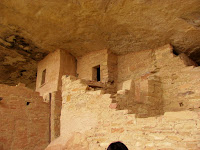
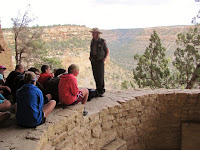 One of
our stops was at one of the kivas with a great view of the canyon as she explained
how they worked. Kiva is a Hopi word
meaning “ceremonial room” though no one is certain what word was used back
then. It seems that kivas were important
to the Ancestral Puebloans as gathering places for religious and social events,
and sometimes even just a
One of
our stops was at one of the kivas with a great view of the canyon as she explained
how they worked. Kiva is a Hopi word
meaning “ceremonial room” though no one is certain what word was used back
then. It seems that kivas were important
to the Ancestral Puebloans as gathering places for religious and social events,
and sometimes even just a
 place to sleep.
These circular pits were located underground accessed by a ladder through
an opening in the roof and consisting of a fire pit, a small hole in the floor representing
the place where they believed that humans first emerged called a sipapu, a
ventilation shaft that brought in fresh air, a deflector consisting of a short
wall between the firepit and the ventilation shaft that deflected the air from putting
out the fire, and small ledges. The
heated air leaving the kiva through the opening in the roof drew the fresh air
in through the shaft. Quite an
place to sleep.
These circular pits were located underground accessed by a ladder through
an opening in the roof and consisting of a fire pit, a small hole in the floor representing
the place where they believed that humans first emerged called a sipapu, a
ventilation shaft that brought in fresh air, a deflector consisting of a short
wall between the firepit and the ventilation shaft that deflected the air from putting
out the fire, and small ledges. The
heated air leaving the kiva through the opening in the roof drew the fresh air
in through the shaft. Quite an
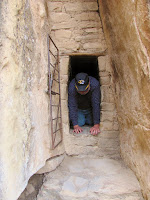 ingenious
system used by our ancient ancestors!
ingenious
system used by our ancient ancestors!
I had taken my smaller, older
camera with me so as not to damage the newer (heavier) one, and this shot at
left shows you just how narrow that opening was that we had to crawl through!
However, you didn’t really have to crawl through the entire length
because in the middle the space was about 6 ft. high so you could stay for a
few feet and then crawl out.
The tour actually lasted almost
1-1/2 hours (Abby made it more like a classroom setting with lots of Q &
A), and we survived this most adventurous tour.
I’m really glad we did it and wish at least one of the others had been
open for a tour, too.
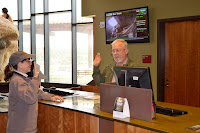 A storm was moving in and could be
seen across the valley as we made our way back down the mountain headed
to the visitor center. We were heading
back there since we were leaving early the next morning so I could get pick up
my 21st Junior Ranger Badge which I had earned on this trip.
A storm was moving in and could be
seen across the valley as we made our way back down the mountain headed
to the visitor center. We were heading
back there since we were leaving early the next morning so I could get pick up
my 21st Junior Ranger Badge which I had earned on this trip.
 discovery. The
overlook’s fence is composed of logs and layers of stones. On one of the cap stones
Russ had noticed what looked like leaves spray painted on top, and he had asked a
nearby ranger
discovery. The
overlook’s fence is composed of logs and layers of stones. On one of the cap stones
Russ had noticed what looked like leaves spray painted on top, and he had asked a
nearby ranger 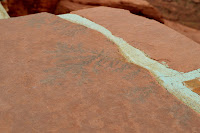 about them. The ranger said he had never noticed them before, but
they were indeed plant fossils…very cool!
about them. The ranger said he had never noticed them before, but
they were indeed plant fossils…very cool! worldly look and feel. The beauty and starkness of
this park is astounding and continues to be one of the top destinations in
worldly look and feel. The beauty and starkness of
this park is astounding and continues to be one of the top destinations in 
